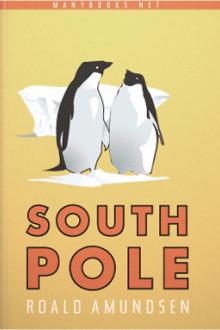A Book of Discovery by M. B. Synge (the snowy day read aloud txt) 📕

- Author: M. B. Synge
- Performer: -
Book online «A Book of Discovery by M. B. Synge (the snowy day read aloud txt) 📕». Author M. B. Synge
Were Asia and America joined together, or was there a strait between the two? The question was yet undecided in 1725. Indeed, the east coast of Asia was only known as far as the island of Yezo, while the Pacific coast of America had been explored no farther than New Albion.
Peter the Great died on 28th January 1725. A week later Behring started for Kamtchatka. Right across snow-covered Russia to the boundary of Siberia he led his expedition. March found him at Tobolsk. With rafts and boats they then made their way by the Siberian rivers till they reached Yakutsk, where they spent their first winter. Not till the middle Of June 1726 did Behring reach the capital of East Siberia. The rest of the journey was through utterly unknown land. It was some six hundred and eighty-five miles eastwards to Okhotsk through a rough and mountainous country, cut up by deep and bridgeless streams; the path lay over dangerous swamps and through dense forest.
The party now divided. Behring, with two hundred horses, travelled triumphantly, if painfully, to Okhotsk in forty-five days. The town consisted of eleven huts containing Russian families who lived by fishing. Snow lay deep on the frozen ground, and the horses died one by one for lack of food, but the undaunted explorer had soon got huts ready for the winter, which was to be spent in felling trees and pushing forward the building of his ship, the Fortuna, for the coming voyage of discovery. Behring himself had made a successful journey to the coast, but some of the party encountered terrible hardships, and it was midsummer 1727 before they arrived, while others were overtaken by winter in the very heart of Siberia and had to make their way for the last three hundred miles on foot through snow in places six feet deep. Their food was finished, famine became a companion to cold, and they were obliged to gnaw their shoes and straps and leathern bags. Indeed, they must have perished had they not stumbled on Behring's route, where they found his dead horses. But at last all was ready and the little ship Fortuna was sailing bravely across the Sea of Okhotsk some six hundred and fifty miles to the coast of Kamtchatka. This she did in sixteen days. The country of Kamtchatka had now to be crossed, and with boats and sledges this took the whole winter. It was a laborious undertaking following the course of the Kamtchatka River; the expedition had to camp in the snow, and few natives were forthcoming for the transport of heavy goods.
It was not till March 1728 that Behring reached his goal, Ostrog, a village near the sea, inhabited by a handful of Cossacks. From this point, on the bleak shores of the Arctic sea, the exploring party were ordered to start. It had taken over three years to reach this starting-point, and even now a seemingly hopeless task lay before them.
After hard months of shipbuilding, the stout little Gabriel was launched, her timber had been hauled to Ostrog by dogs, while the rigging, cable, and anchors had been dragged nearly two thousand miles through one of the most desolate regions of the earth. As to the food on which the explorers lived: "Fish oil was their butter and dried fish their beef and pork. Salt they were obliged to get from the sea." Thus supplied with a year's provisions, Behring started on his voyage of discovery along an unknown coast and over an unknown sea. On 13th July 1728 the sails of the Gabriel were triumphantly hoisted, and Behring, with a crew of forty-four, started on the great voyage. His course lay close along the coast northwards. The sea was alive with whales, seals, sea-lions, and dolphins as the little party made their way north, past the mouth of the Anadir River. The little Gabriel was now in the strait between Asia and America, though Behring knew it not. They had been at sea some three weeks, when eight men came rowing towards them in a leathern boat. They were the Chukches—a warlike race living on the north-east coast of Siberia, unsubdued and fierce. They pointed out a small island in the north, which Behring named the Isle of St. Lawrence in honour of the day. Then he turned back. He felt he had accomplished his task and obeyed his orders. Moreover, with adverse winds they might never return to Kamtchatka, and to winter among the Chukches was to court disaster. After a cruise of three months they reached their starting-point again. Had he only known that the coast of America was but thirty-nine miles off, the results of his voyage would have been greater. As it was, he ascertained that "there really does exist a north-east passage, and that from the Lena River it is possible, provided one is not prevented by Polar ice, to sail to Kamtchatka and thence to Japan, China, and the East Indies."
The final discovery was left for Captain Cook. As he approached the straits which he called after Behring, the sun broke suddenly through the clouds, and the continents of Asia and America were visible at a glance.
There was dissatisfaction in Russia with the result of Behring's voyage, and though five years of untold hardship in the "extremest corner of the world" had told on the Russian explorer, he was willing and anxious to start off again. He proposed to make Kamtchatka again his headquarters, to explore the western coast of America, and to chart the long Arctic coast of Siberia—a colossal task indeed.
So the Great Northern Expedition was formed, with Behring in command, accompanied by two well-known explorers to help, Spangberg and Chirikoff, and with five hundred and seventy men under him. It would take too long to follow the various expeditions that now left Russia in five different directions to explore the unknown coasts of the Old World. "The world has never witnessed a more heroic geographical enterprise than these Arctic expeditions." Amid obstacles indescribable the north line of Siberia, hitherto charted as a straight line, was explored and surveyed. Never was greater courage and endurance displayed. If the ships got frozen in, they were hauled on shore, the men spent the long winter in miserable huts and started off again with the spring, until the northern coast assumed shape and form.
One branch of the Great Northern Expedition under Behring was composed of professors to make a scientific investigation of Kamtchatka! These thirty learned Russians were luxuriously equipped. They carried a library with several hundred books, including Robinson Crusoe and Gulliver's Travels, seventy reams of writing-paper, and artists' materials. They had nine wagonloads of instruments, carrying telescopes fifteen feet long. A surgeon, two landscape painters, one instrument maker, five surveyors accompanied them, and "the convoy grew like an avalanche as it worked its way into Siberia." Behring seems to have moved this "cumbersome machine" safely to Yakutsk, though it took the best part of two years. Having left Russia in 1733, it was 1741 when Behring himself was ready to start from the harbour of Okhotsk for the coast of America with two ships and provisions for some months. He was now nearly sixty, his health was undermined with vexation and worry, and the climate of Okhotsk had nearly killed him.
On 18th July—just six weeks after the start—Behring discovered the continent of North America. The coast was jagged, the land covered with snow, mountains extended inland, and above all rose a peak towering into the clouds—a peak higher than anything they knew in Siberia or Kamtchatka, which Behring named Mount St. Elias, after the patron saint of the day. He made his way with difficulty through the string of islands that skirt the great peninsula of Alaska. Through the months of August and September they cruised about the coast in damp and foggy weather, which now gave way to violent storms, and Behring's ship was driven along at the mercy of the wind. He himself was ill, and the greater part of his crew were disabled by scurvy. At last one day, in a high-running sea, the ship struck upon a rock and they found themselves stranded on an unknown island off the coast of Kamtchatka. Only two men were fit to land; they found a dead whale on which they fed their sick. Later on sea-otters, blue and white foxes, and sea-cows provided food, but the island was desolate and solitary—not a human being was to be seen.
THE CHART OF BEHRING'S VOYAGE FROM KAMTCHATKA TO NORTH AMERICA THE CHART OF BEHRING'S VOYAGE FROM KAMTCHATKA TO NORTH AMERICA.From a chart drawn in 1741 by Lieut. Waxell, a member of Behring's expedition. It is also interesting for the drawing of the sea-cow, one of the very few authentic drawings of this curious animal, which has long been extinct, and is only known by these drawings.
Here, however, the little party was forced to winter. With difficulty they built five underground huts on the sandy shore of the island now known as Behring Island. And each day amid the raging snowstorms and piercing winds one man went forth to hunt for animal food.
Man after man died, and by December, Behring's own condition had become hopeless. Hunger and grief had added to his misery, and in his sand-hut he died. He was almost buried alive, for the sand rolled down from the pit in which he lay and covered his feet. He would not have it removed, for it kept him warm. Thirty more of the little expedition died during that bitter winter on the island; the survivors, some forty-five persons, built a ship from the timbers of the wreck, and in August 1742 they returned to Kamtchatka to tell the story of Behring's discoveries and of Behring's death.
But while the names of Torres, Carpenter, Tasman, and Dampier are still to be found on our modern maps of Australia, it is the name of Captain Cook that we must always connect most closely with the discovery of the great island continent—the Great South Land which only became known to Europe one hundred and fifty years ago.
Dampier had returned to England in 1701 from his voyage to New Holland, but nearly seventy years passed before the English were prepared to send another expedition to investigate further the mysterious land in the south.
James Cook had shown himself worthy of the great command that was given to him in 1768, although exploration was not the main object of the expedition. Spending his boyhood in the neighbourhood of Whitby, he was familiar with the North Sea fishermen, with the colliers, even with the smugglers that frequented this eastern coast. In 1755 he entered the Royal Navy, volunteering for service and entering H.M.S. Eagle as master's mate. Four years later we find him taking his share on board H.M.S. Pembroke in the attack on Quebec by Wolfe, and later transferred to H.M.S. Northumberland, selected to survey the river and Gulf of St. Lawrence. So satisfactory was his work that a few years later he was instructed to survey and chart the coasts of Newfoundland and Labrador. While engaged on this work, he observed an eclipse of the sun, which led to the appointment that necessitated a voyage to the Pacific Ocean. It had been calculated that a Transit of Venus would occur in June 1769. A petition to the King set





Comments (0)